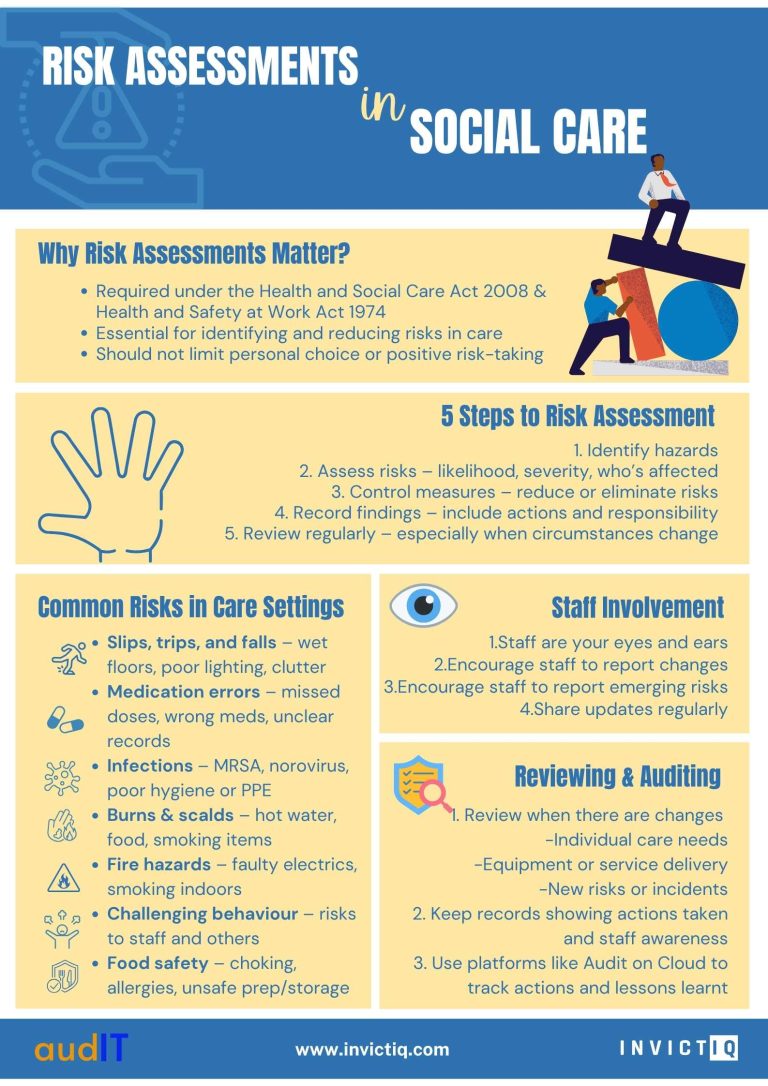@2021 invictIQ is a venture by Sprint Consultancy. All rights reserved. Privacy Policy.

Risk Assessments in Social Care
by Mark Topps
Last week I touched on the importance of care planning, and what should be included and how to review them. If you missed this, you can read it here. I mentioned in this blog that you should triangulate the care plan with risk assessments, and had a couple of new managers reach out to be about this. I thought I would use the blog this week to explore risk assessments within social care, what they are, why they matter, how to review them and why they will help you within your next inspection.
Why Risk Assessments Matter
Risk assessments are a regulatory requirement under the Health and Social Care Act 2008 and Health and Safety at Work Act 1974 and are fundamental to delivering safe care through identifying and mitigating hazards.
We do need to be mindful that we do not allow risk assessments to prevent people from making their own choices and taking positive risks. I have seen all to often them restrict people from living their best life!
Common Risks
There isn’t a checklist of risk assessments you need to complete, and it really is service specific.
The HSE state: “People who work in health and social care have the right to work in a healthy and safe workplace, and the people using services are entitled to care and support that is safe and takes their needs, freedom and dignity into account”
The CQC Single Assessment Framework has a section (Involving People to Manage Risks) which states “We work with people to understand and manage risks by thinking holistically so that care meets their needs in a way that is safe and supportive and enables them to do the things that matter to them”
Whilst there is no list, here are some of the most frequently encountered risks identified by the HSE and CQC in both domiciliary and care home environments
- Slips, Trips and Falls caused by slippery floors, poor lighting or cluttered walkways
- Medication Errors caused by incorrect dosages, missed medications or drug interactions. Risks increase when multiple carers are involved or when service users self-administer.
- Infections like MRSA or norovirus combined with poor hygiene practices or inadequate PPE
- Burns and Scalds caused by hot water, hot water bottles, food and smoking
- Fires caused by electrical faults and smoking
- Challenging Behaviour
- Food Safety, allergies, choking hazards
How to Carry Out a Risk Assessment
I wont dive in depth into this, as there are so many great resources and blogs on carrying out risk assessments, but essentially there are five steps:
- Identify the hazards
- Assess the risks, determining the likelihood and severity of harm and who might be affected and how.
- Implement control measures to eliminate or reduce risks
- Record findings, including the actions being taken and who is responsible.
- Review and update as required.
Reviewing and Auditing
Whilst there are many great resources, not many will talk about the role of your staff. Remember, they are the eyes and ears of your service and it is likely they will notice subtle changes, highlight where protocols are not working, be able to identify new and emerging risks etc. You just need to consider how you will harness obtaining this feedback.
You should be reviewing risk assessments when there are changes to the identified risk, changes in your service, when the person you are supporting has a change in their support needs, if new mechanisms are introduced etc.
CQC and HSE officials will be looking for reassurance that you have identified and assessed all risks, that risk assessments for your staff and the people you support are tailored to them, that they are reviewed regularly, that your documentation evidences the actions taken (and follow up actions) and that there is evidence of staff being made aware of risks (think about how you cascade this to your team, and this could be via team meetings, internal communication platforms etc).
Remember, non-compliance can lead to enforcement actions, including fines, restrictions or closure of your service. It is definitely worth being on top of how you risk assess and review. I have always found having a risk register has helped with this. Some further reading resources:
www.hse.gov.uk/healthservices/sensible-risk-assessment-care-settings.htm
Consider using a dedicated platform like Audit on Cloud by InvictIQ to strengthen your risk management approach. It enables structured tracking of actions and lessons learnt across care services, ensuring accountability, timely follow-up, and clear documentation—supporting proactive risk response, compliance, and high-quality, safe care delivery.
MORE ARTICLES


Mark Topps is a social care leader who has worked in the care industry since 2004 and is currently working as a regional support manager. He regularly advocates, appearing on television, radio and podcasts and has started many campaigns for change in legislation and culture within the industry. Mark is the co-founder of The Caring View which is a social care podcast, YouTube show and free resource initiative for the sector. He also co-founded The Health and Social Care Club, which is an audio event hosted on LinkedIn. Mark is also the social media and marketing director at the National Association of Care and Support Workers.
Sign up for our newsletter
